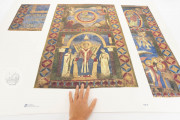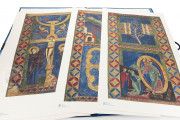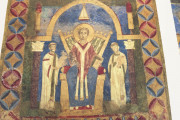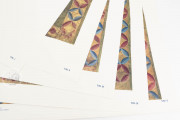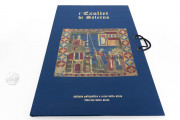Exultet rolls are named for the first word of the chant sung at the culmination of the liturgy of the Christian holiday of Easter at the moment of the lighting of the Paschal candle. This powerful and expressive chant announces the Resurrection of Christ: Exultet iam angelica turba caelorum (Rejoice now, angelic choir of the heavens!). This type of liturgical scroll was originally commissioned by Archbishop Landulf of Benevento around 960-970, and the scrolls were decorated with a long series of images. They are linked to the Beneventan rite of the southern Italian peninsula and are unique to the region. The majority of the surviving rolls are datable between the tenth and fourteenth centuries, and the Salerno Exultet Roll was produced between 1225 and 1227.
Twenty-eight Exultet scrolls survive. Unlike the others, the Salerno Exultet was designed from the very outset with little text. The roll only includes the beginning of the Easter proclamation heralded by a large illuminated initial E and three lines of its text in gilded capitals on the first sheet. The remainder of the roll consists of images in sumptuous colors. Continuous ornamental bands of alternating red and blue rosettes on a lavish gold ground frame the length of the roll and would have had a dramatic luminous effect when unfurled in the candlelight.
Manuscript as Performance
Exultet rolls were made for public ritual viewing, and their use was part of a multi-sensory theatrical experience that celebrated the return of light in the liturgy of the Easter vigil. After the church was in complete darkness and silence, the deacon would touch the Easter candle and chant the text. The roll would unravel over the edge of the pulpit as the chant continued, and its images would be visible to the congregation. Essential here is the significance of movement to manuscripts: these were not static objects but necessitated activation by readers.
As a scroll that could physically approach its viewers and was accompanied by chant, the Exultet Roll had even further symbolic and performative potential. To facilitate viewing, the images were placed upside down with respect to the text. Although the Salerno Exultet Roll only contained the beginning of the chant, its text was nonetheless inverted so that it could be read by the deacon while the images exhibited to the congregation were correctly oriented.
Beneventan Script in Gold Capitals
Given the development of the Exultet Roll in the Beneventan region and its tie to the Beneventan liturgy, almost all the rolls are written in the local Beneventan Minuscule script. This script is primarily found in manuscripts from the mid-eighth to the thirteenth century made south of Rome in the Duchy of Benevento. The chant incipits are rendered in large gold capitals and would have shone by the light of the Easter candle.
Commissioned by the Archbishop of Salerno
The date of the Salerno Exultet was much disputed before the identification of Frederick II, Holy Roman Emperor, within its final commemoration scene. The emperor was excommunicated in September 1227, which gives a probable terminus ante quem (point before which) for its creation. Scholars have persuasively tied the creation of the roll with the investiture of Cesario d'Alagno in 1225 as the new archbishop of Salerno. He is the most likely to have commissioned this roll. He also makes an appearance at the pope’s right hand in the penultimate image commemorating the ecclesiastical authorities. Thus, the Salerno Exultet Roll was in all probability a local product that remained in the possession of the cathedral without changing hands for the past eight centuries.
We have 1 facsimile edition of the manuscript "Salerno Exultet Roll": Exultet di Salerno facsimile edition, published by Istituto Poligrafico e Zecca dello Stato, 1993
Request Info / Price




